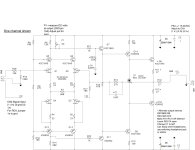I have some you can have. I sent you a private message, shoot me an address and I'll drop them in the mail to you.
... Dr. Lenny Novikov. He has graciously offered for me to send my ailing MCL unit to him for further troubleshooting. He is fairly sure the entire board is not dead and already has an idea that I may have given one of the chipsets a static charge that removed the instruction set.
Avowal time. As I was prepping my MCL board for shipment back to Lenny, I discovered that one of my earlier attempts to connect a different power button had been wired to the wrong location. So guess who monkeyed the MCL board up? Yours truly. 😳 In the end it wasn't any static charge, it was just me digging in my box of stupidity for an answer.
Thanks for asking, and yes I did. I connected each VRDN to the next one, then connected the last one to star ground. I even connected the ISS board to the BA2018 board set, and things seem wonderfully quiet. My work has slowed due to impending holidays but I sneak away here and there...
I know this has been discussed before but I could not find the fix by searching. When hooking up headphones, how do you eliminate the buzzing and popping that happens when the headphone jack is inserted?
Don't plug them in and out when it's turned on. ;-) That's my strategy.
Someone else will have to give a real answer. But I think you can connect high-value (e.g., 1M) resistors between the signal legs and ground. You see these 'pull down' resistors at the inputs in many audio circuits. Not just preamps, etc, but also guitar pedals.
Someone else will have to give a real answer. But I think you can connect high-value (e.g., 1M) resistors between the signal legs and ground. You see these 'pull down' resistors at the inputs in many audio circuits. Not just preamps, etc, but also guitar pedals.
I'm a total amateur, so I'd definitely wait until someone else confirms. I was just looking at the schematic for the Whammy, and it does not have those sorts of resistors either. But the B1 does.
Merry Xmas to all!
I built my unit using the stock transistors and 6L6 graciously had send me the bigger output transistors suitable for headphone connections with some comments regarding some differences in the mounting of some components to implement this. I do not recall or find the communication and would like to find some information regarding that in the thread, but I cannot find it if I search for headphone or some variation of that. My board I’d the blue one…
Thanks!
I built my unit using the stock transistors and 6L6 graciously had send me the bigger output transistors suitable for headphone connections with some comments regarding some differences in the mounting of some components to implement this. I do not recall or find the communication and would like to find some information regarding that in the thread, but I cannot find it if I search for headphone or some variation of that. My board I’d the blue one…
Thanks!
A question to those built this, anyone done some measurement on completed board with parts kit from the store? I mostly want to know how close left/right matched, in terms of gain, SINAD, etc. Thanks.
If you build this with the store kit it should very closely match the original measurements in my presentation.
With 1% parts they should be within one percent of each other although typically better. Dale 1% parts are usually closer to .1% in my experience.
With 1% parts they should be within one percent of each other although typically better. Dale 1% parts are usually closer to .1% in my experience.
Thanks, I have read some "science review" from another forum, found it's not uncommon having channel matching issue for commercial products, even some have good reputation.
The biggest contributor to uneven volume between left and right channels is typically the volume potentiometer. Physically small stereo pots don't track as well as larger units, particularly at low volumes. Pete Millett said it concisely, "Unfortunately, all small (and cheap) volume controls suck. They have lots of channel mismatch, and they are noisy or get nosier with time."
If you are wanting more precision, the easiest (though not the cheapest) thing will be to use a stepped attenuator for volume, so the tracking will be identical with every step.
If you are wanting more precision, the easiest (though not the cheapest) thing will be to use a stepped attenuator for volume, so the tracking will be identical with every step.
Just to agree: I find that it's well worth the money to use a really good volume pot. Granted, you'll pay as much for one as you do to build the whole preamp (well, depending upon what you do for a case). But not only do you get good stereo balance, you get better sound generally, since the resistors used in a good stepped attenuator are much higher quality than the strippy things they use in cheap ones.
I am personally partial to the Khozmo attenuators. Stereo can be had for $176 at the moment.
I am personally partial to the Khozmo attenuators. Stereo can be had for $176 at the moment.
I used a (cheap) steppen attenuator at first, thee I bought an attenuator from Academy Audio. The difference was like day and night.
I've been wanting to try a Muse volume control for a while. Those look interesting. Not cheap, though.
- Home
- Amplifiers
- Pass Labs
- Wayne's BA 2018 linestage
